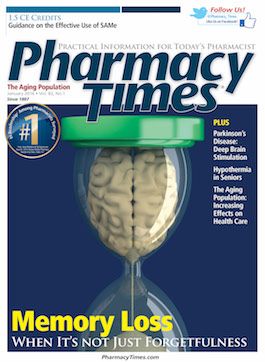Drugs Affecting Levothyroxine Absorption
A recent study assessed thyroidstimulating hormone and levothyroxine dosage in 5426 outpatients who had been prescribed levothyroxine, along with drugs that can impair levothyroxine absorption or affect levothyroxine metabolism.
A recent study assessed thyroidstimulating hormone (TSH) and levothyroxine dosage in 5426 outpatients who had been prescribed levothyroxine, along with drugs that can impair levothyroxine absorption (ie, antacids, iron, sucralfate, cholestyramine, orlistat, sevelamer, and proton pump inhibitors) or drugs that can affect levothyroxine metabolism (carbamazepine, phenobarbital, phenytoin).1 As expected, the TSH level significantly increased after the interacting drugs were initiated, and the subsequent levothyroxine dosage was increased, as well. These findings are consistent with drug—drug interactions that reduce levothyroxine serum concentrations, leading to a compensatory increase in TSH level and the need to increase levothyroxine dosage. This study has the advantage of a large sample size, and it certainly suggests that these interacting drugs may have a clinically important effect on levothyroxine serum concentrations. Nonetheless, the effect of individual drugs on levothyroxine cannot be determined because so many different drugs were studied and the results were lumped together.
Drugs that Impair Levothyroxine Absorption
A number of drugs have been shown to impair the absorption of levothyroxine; these drugs include calcium carbonate, aluminum- containing antacids, sucralfate, iron supplements, cholestyramine, sevelamer, and, possibly, ciprofloxacin, raloxifene, and orlistat.2-5 The magnitude of virtually all drug interactions tends to vary substantially from one individual to another, and the same should be expected with these interactions. In one study on the effect of long-term calcium carbonate therapy in 20 hypothyroid patients stabilized on levothyroxine, the TSH level increased in 13 patients (in 4, above the normal range), was unchanged in 4 patients, and decreased in 3 patients.5 This is probably more variable than some other absorption interactions, in which the binding is strong enough to dramatically reduce the absorption of the affected drug in virtually every patient (eg, ciprofloxacin with aluminum hydroxide).
One factor that probably contributes to the variability of levothyroxine drug—drug interactions is that some individuals are completely dependent on exogenous levothyroxine (eg, following total thyroidectomy) while others have varying degrees of residual thyroid function. Those with some thyroid function may also have varying degrees of feedback stimulation of endogenous thyroid release via thyroidreleasing hormone and TSH.
Proton pump inhibitors (PPIs) have also been reported to reduce levothyroxine absorption, presumably, through an increase in gastric pH, thus reducing dissolution of the levothyroxine tablets. The bulk of evidence suggests that PPIs reduce levothyroxine absorption,2-4,6 although one small study failed to find an interaction between levothyroxine and omeprazole.7 In the outpatient study cited in the introduction, almost 70% of the interacting drugs were PPIs. One study found that replacing levothyroxine tablets with an oral solution improved levothyroxine absorption in the presence of PPIs.8
Summary
A variety of medications can inhibit the absorption of levothyroxine, probably by binding with levothyroxine in the gut. It is rarely necessary to avoid binding agents in patients taking levothyroxine, so if the patient needs to receive the binding agent, the following precautions can minimize the risk of an adverse outcome (note: the first 2 bullet points do not apply to proton pump inhibitors because they probably do not bind levothyroxine):
- Administer levothyroxine at least 2 hours before or 4 hours after the binding agent.
- Keep the interval between the levothyroxine and binding agent as constant as possible.
- Monitor the TSH level and watch for clinical evidence of a reduced levothyroxine effect.
- If the binding agent is discontinued or its dosage changed, or if the interval between the levothyroxine and binding agent is changed, monitor the TSH level, and watch for an altered levothyroxine response.
Drs. Horn and Hansten are both professors of pharmacy at the University of Washington School of Pharmacy. For an electronic version of this article, including references, if any, visit www.hanstenandhorn.com.
References
- Trifiro G, Parrino F, Sultana J, et al. Drug interactions with levothyroxine therapy in patients with hypothyroidism: observational study in general practice. Clin Drug Invest. 2015;35(3):187-195.
- Irving SA, Vadiveloo T, Leese GP. Drugs that interact with levothyroxine: an observationalstudy from the Thyroid Epidemiology, Audit and Research Study (TEARS). Clin Endocrinol (Oxford). 2015;82(1):136-141.
- Liwanpo L, Hershman JM. Conditions and drugs interfering with thyroxine absorption. Best Pract Res Clin Endocrinol Metab. 2009;23(6):781-792.
- Benvenga S. When thyroid hormone replacement is ineffective? Curr Opin Endocrinol Diabetes Obes. 2013;20(5):467-477.
- Singh N, Singh PN, Hershman JM. Effect of calcium carbonate on the absorption of levothyroxine. JAMA. 2000;283(21);2822-2825.
- Sachmechi I, Reich DM, Aninyei M, Wibowo F, Gupta G, Kim PJ. Effect of proton pump inhibitors on serum thyroid-stimulating hormone level in euthyroid patients treated with levothyroxine for hypothyroidism. Endocr Pract. 2007;13(4):345-349.
- Abi-Abib Rde C, Vaisman M. Is it necessary to increase the dose of levothyroxine in patients with hypothyroidism who use omeprazole? Arq Bras Endocrinol Metabol. 2014;58(7):731-736.
- Vita R, Saraceno G, Trimarchi F, Benvenga S. Switching levothyroxine from the tablet to the oral solution formulation corrects the impaired absorption of levothyroxine induced by proton-pump inhibitors. J Clin Endocrinol Metab. 2014;99(12):4481-4486.

